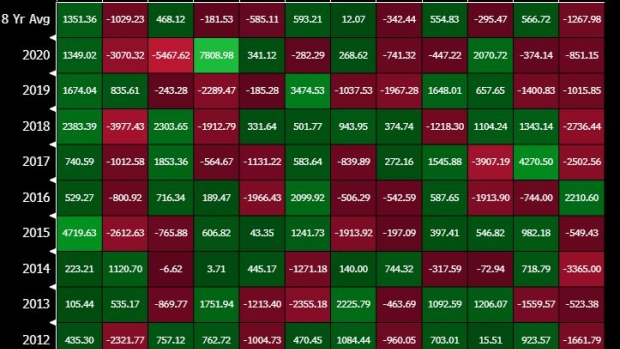Jan 7, 2021
Five Things to Like About Indonesian Bonds as 2021 Gets Underway
, Bloomberg News

(Bloomberg) -- Indonesian bonds have returned more than 10% in each of the past two years, and the start of 2021 may see further gains, a range of metrics shows.
Bullish factors include investors anticipating gains in the rupiah over the next 12 months, the fact that local debt has seen inflows in January for the past nine years, and the allure of real yields that are among the highest in emerging markets. Relatively light positioning, and the positive spread between 10-year yields and the cost of financing are also set to provide tailwinds.
Below are charts illustrating each of these factors:
The spread between one- and 12-month rupiah non-deliverable forwards has dropped below 500 basis points after being as high as 1,100 basis points during the peak of the coronavirus outbreak early last year. The tightening shows overseas investors are growing increasingly bullish on the rupiah over the period. If the currency strengthens as expected, that would juice up returns for rupiah bond holders.
2. January Inflows
January also marks the start of seasonal flows that tend to favor Indonesian bonds, with the month having seen net inflows for nine straight years. This beginning of 2021 may be even more bountiful than usual due to the completion of the U.S. Senate runoff votes in Georgia. The removal of uncertainty around the U.S. presidential election in the first week of November saw bond inflows jump to $851 million the following week, the most in more than 12 months.
Rupiah debt stands out as offering some of the highest real yields in emerging markets. Ten-year bonds in the country offer yields of about 3.6% after adjusting for expected inflation in 2021 of 2.3%, which is the median forecast of economists surveyed by Bloomberg. While that level may sound relatively modest, bear in mind that the amount of negative-yielding debt around the world recently climbed to a record $18 trillion.
Foreign positioning in Indonesian bonds also remains comparatively light versus other developing markets. Outflows have been relatively high over the past 12 months, climbing to two standard deviations away from the five-year average. That suggests global funds now have significant scope to beef up their holdings in coming months -- particularly as the securities are seen as being positively correlated to the global recovery.
Finally, rupiah debt appear attractive from a financing perspective, especially for local investors. The spread of 10-year yields over the three-month Jakarta interbank rate is around 190 basis points, comfortably above the three-year average of about 130 basis points. That may have helped boost demand at the first auction of the year this week, which attracted total bids of 91 trillion rupiah ($6.5 billion), close to the record 103.6 trillion rupiah set in June.
That’s not to say the securities are free from risk. The central government is ramping up bond issuance to help it fight the impact of the coronavirus, while efforts to shrink the budget deficit may by stymied by the cost of giving free vaccines to the entire population. On balance though, there appears a lot more to like than dislike about Indonesian debt as 2021 begins.
What to Watch
- Malaysia will report industrial production figures for November on Monday after output fell in October for the first time in four months
- Thailand will sell 6 billion baht ($200 million) of 2049 bonds (LB496A) on Wednesday
- The Philippines is due to release November remittances data next week
Note: Marcus Wong is an EM macro strategist who writes for Bloomberg. The observations he makes are his own and not intended as investment advice.
©2021 Bloomberg L.P.